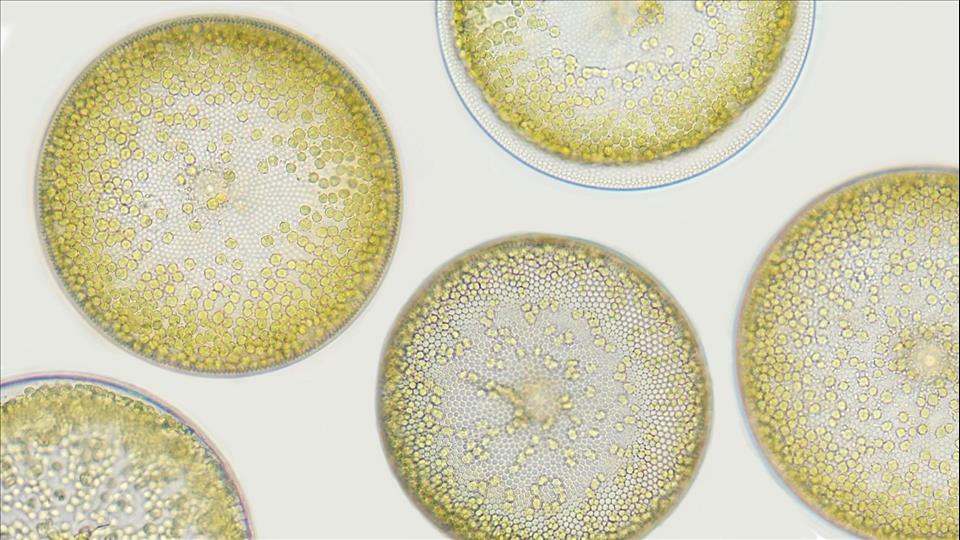
Plankton Mark Seasons In The Sea, Just Like Leaves And Flowers On Land
As UK seas warm and cool with the seasons, the composition and abundance of these plankton communities naturally change . Like plants and animals on land, marine plankton undergo annual cycles that are dictated by seasonal patterns of light, temperature, and settled or unsettled weather. But unlike seasonal patterns on land, the ways plankton shift with the seasons – by migrating, eating, mating, blooming, reproducing or dying – are mostly invisible to the naked eye.
Early each spring, as waters around the UK warm and days lengthen, phytoplankton (single-celled algae) begin to reproduce by dividing, creating a spring“bloom”. This event is similar to the mass flowering of daffodils and crocuses that happens around the same time on land and transforms the dull brown of winter into green.
The UK's spring phytoplankton bloom is normally dominated by diatoms , a group of phytoplankton that come in beautiful shapes. Encased in glass-like silica shells, diatoms are mostly green due to the chlorophyll they contain.
Diatoms are algae that live in houses made of glass. Scenics & Science/Alamy Stock Photo
The spring bloom of these microscopic algae is quickly followed by a rapid increase in zooplankton – microscopic animals that feast on the verdant phytoplankton. If you examine a sample of seawater under a microscope in spring, you will see tiny crustaceans known as copepods which spend their whole lives as plankton and are a key source of food for fish.
You will also see animals that you probably wouldn't recognise in their microscopic planktonic form, but that grow into crabs, lobsters, worms and barnacles. As these larvae grow by feeding on phytoplankton and then eventually smaller zooplankton, they moult into different shapes until they resemble their adult forms and settle on the shore where you can eventually spot them in rock pools.
Do the seasons feel increasingly weird to you? You're not alone. Climate change is distorting nature's calendar, causing plants to flower early and animals to emerge at the wrong time.
This article is part of a series, Wild Seasons , on how the seasons are changing – and what they may eventually look like.
Throughout summer, the abundance of phytoplankton is kept in check by zooplankton, until late summer and early autumn when stormy weather stirs up nutrients from deeper waters.
These nutrients act as fertiliser for phytoplankton at the surface which burst into abundance again. This time dinoflagellates are the star: a different type of phytoplankton that moves with a whip-like tail (or“flagella”). Once more, surging populations of zooplankton grazers mop up this phytoplankton bloom.
As autumn turns to winter the sea cools and the days shorten. With less light and cooler waters, phytoplankton populations drop off and so do zooplankton. Both remain low over the winter, until spring, when the cycle starts again.
Blooming confusingGlobal heating has produced warmer winters and an earlier onset of spring in temperate parts of the world like the UK. Daffodils and butterflies are appearing earlier and earlier .
Climate change is also affecting the seasonal cycle of North Atlantic plankton. Spring seas warm earlier, causing some phytoplankton to bloom earlier in the calendar year which brings the entire spring bloom forward. Sea temperatures also stay warm for longer, pushing autumn plankton blooms until later in the year.
Phytoplankton blooms are visible from space as colourful swirls in the ocean. Best-Backgrounds/Shutterstock
Not all phytoplankton and zooplankton species are responding the same way to climate change. The change in timing of zooplankton blooms may not synchronise with the changed timing of phytoplankton blooms, resulting in less food for zooplankton. Scientists call this shift a“trophic mismatch”, because predator and prey are not in sync. There is some evidence of a trophic mismatch in North Atlantic plankton , but other research has shown that trophic mismatches are not consistently occuring and may in fact be unrelated to temperature.
The reason why it is unclear if a trophic mismatch is happening among UK plankton is because plankton around the UK are so diverse. Hundreds of species respond differently to changes in light, temperature and nutrients.
Some species may thrive in warmer conditions while others struggle. Some species do well only in some, but not all, warm years. Part of the reason for these inconsistent responses is that there are other processes controlling populations of plankton, such as fishing, the introduction of nutrients by people (like fertilisers spilling off farmland and into the sea) and predation.
Climate-driven trophic mismatches may be occurring in some UK marine ecosystems some times, but they are probably not happening consistently everywhere.
What we do know, however, is that climate change is altering the normal seasonal patterns of plankton, increasing the potential for trophic mismatches to occur.
As you watch the trees change colour this autumn and daffodils burst into bloom in spring, remember that the plankton communities in UK seas are undergoing a similar seasonal cycle. This may only be visible with a microscope, but it is just as important to the ocean as the seasonality seen on land – and just as vulnerable to climate change.

Legal Disclaimer:
MENAFN provides the
information “as is” without warranty of any kind. We do not accept
any responsibility or liability for the accuracy, content, images,
videos, licenses, completeness, legality, or reliability of the information
contained in this article. If you have any complaints or copyright
issues related to this article, kindly contact the provider above.


















Comments
No comment